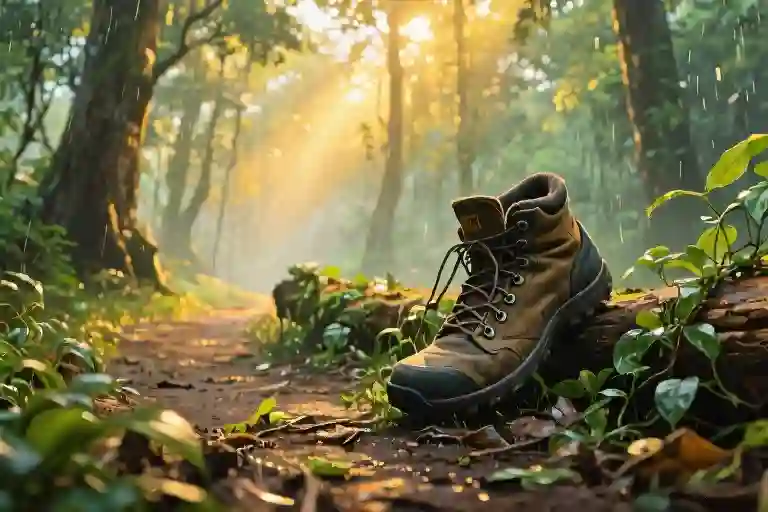The humid air hit my face like a warm, living blanket as I stepped off the wooden plank onto Taman Negara’s ancient soil. Towering dipterocarp trees whispered overhead, their canopies filtering sunlight into liquid gold that pooled around my hiking boots. Somewhere in the distance, a hornbill’s call echoed—the same sound that should have welcomed a honeymooning couple 49 years ago. Instead, it greeted a divorced woman carrying a backpack and enough emotional baggage to sink a riverboat.
This rainforest had been on my bucket list since college, when I’d circled Malaysia on a map with red marker, dreaming of adventures with my then-fiancé. Life, as it tends to do, happened. Jobs, mortgages, and eventually divorce papers piled up like layers of sediment over those dreams. The final flush came when our honeymoon plans—along with so many other shared fantasies—swirled down the drain with the disinfectant of separation.
My fingers brushed against the wrinkled trail map in my pocket, its creases holding more history than topography. At 49, I stood alone where two 20-somethings had promised to stand together. The irony wasn’t lost on me as I adjusted my straps: sometimes the journeys we postpone become the ones that save us.
Around me, the rainforest pulsed with the kind of primal energy that makes city dwellers catch their breath. Cicadas tuned their symphony, their vibrations traveling up through the soles of my shoes. The scent of damp earth and decomposing leaves—nature’s relentless cycle of death and rebirth—filled my nostrils. Every sense shouted that this was a place of transformation, where vines strangled old growth to make way for new, where floods reshaped the land without apology.
A raindrop splashed onto my wristwatch, the one I’d bought myself after selling my wedding band. The glass face reflected not the young bride I’d been, but the woman who’d survived a decade of depression’s slow erosion. The woman who’d finally realized that healing isn’t about waiting for storms to pass, but learning to dance in the rain—even if that meant dancing solo through the oldest rainforest on Earth.
The Decade in the Cave: From Divorce to Depression
For ten long years, I lived like a hermit crab that had outgrown its shell but refused to leave. My divorce papers arrived in a manila envelope thinner than the wedding invitations we’d sent out fifteen years earlier. That envelope contained all the legal finality of a relationship that had once promised ‘forever’ – now reduced to three notarized pages and a court stamp.
The Self-Dug Hole
I developed what therapists might call ‘maladaptive coping mechanisms,’ though I prefer my own term: burrowing. Each night became an excavation project – digging deeper into the rabbit hole of my ex-husband’s social media, analyzing every like, every comment from female coworkers, every check-in at restaurants we’d once frequented. My laptop’s glow became my cave’s only light source, the keyboard developing a permanent indentation where my right pinkie rested against the ‘refresh’ key.
The refrigerator became an archaeological dig of my deteriorating mental state. A science experiment in takeout containers – Thai curry from week three developing fuzzy topography, the Chinese dumplings from month two liquefying into primordial soup. My grocery deliveries shifted from fresh produce to frozen meals, then finally to just wine and saltines. The delivery guy stopped making small talk.
The Weight of Expectations
What nobody tells you about divorce after forty is how suddenly you become everyone’s project. My married friends developed this new habit of ‘casually’ mentioning their recently single coworkers. My aunt mailed me brochures for dating websites with handwritten notes like ‘Even Carol from church found someone!’ as if romantic partnership was the only valid form of human completion.
When I first floated the idea of traveling alone to Taman Negara – a trip originally on our honeymoon list – the reactions ranged from concerned to condescending:
- ‘But who will take your photos?’ (As if selfies hadn’t been invented)
- ‘Isn’t it dangerous for a woman your age?’ (I was forty-seven, not ninety-seven)
- ‘Maybe wait until you meet someone new?’ (The implication being solo travel was just temporary purgatory)
The Turning Point
For a decade, I let these voices – both external and internal – keep me underground. Then in 2020, the world turned upside down. COVID-19 didn’t just disrupt normalcy; it ripped the roof clean off my carefully constructed cave. As lockdowns forced everyone into isolation, my decade of self-imposed solitude suddenly became the global norm. But where others panicked at the sudden loneliness, I realized with startling clarity: I’d been preparing for this my whole adult life.
When I finally contracted the virus in late 2023 (because of course my immune system waited until everyone else had moved on), something shifted. Lying in bed with a 103-degree fever, watching the news report death tolls like weather forecasts, it hit me: I’d spent ten years waiting – for closure, for permission, for some imaginary future where everything would magically realign. Meanwhile, the ancient trees of Taman Negara had been growing for 130 million years without checking anyone’s relationship status.
That’s when the cave walls finally started crumbling. Not with a dramatic earthquake, but with the quiet realization that had been whispering to me for years: The only disinfectant strong enough to clean my wounds wasn’t alcohol or bleach – it was fresh air, unfamiliar trails, and the courage to travel solo after divorce.
The Wake-Up Call: Vulnerability and the Bucket List
Lying in a hospital bed with an oxygen mask strapped to my face, I finally understood what it meant to be a statistic. The COVID ward’s fluorescent lights hummed overhead as I stared at the ceiling, counting the perforations in the acoustic tiles – 47, 48, 49 – mirroring the years I’d postponed my rainforest adventure. In that moment, the abstract numbers from news reports became painfully personal: the 6.9 million global deaths included me, or nearly did.
When Invincibility Shattered
For three years, I’d watched the pandemic unfold from what I imagined was a safe distance. Like many, I developed a false sense of security after initial lockdowns eased. “I’m healthy,” I’d tell myself while sanitizing groceries, “I’ve survived divorce, depression, what’s a virus?” The arrogance of that thought now makes me cringe. When the fever hit in November 2023, it wasn’t the physical symptoms that terrified me most (though the 104°F temperature certainly got my attention), but the psychological whiplash of realizing my mortality.
During those sleepless nights, an unexpected clarity emerged. As nurses checked my vitals every two hours, their PPE suits rustling like the rainforest leaves I’d never touched, I mentally revisited my old adventure list. Not the romanticized “couple’s bucket list” from my marriage, but the authentic, ink-smudged notebook where 19-year-old me had scribbled dreams of canopy walks and night safaris. The pages smelled faintly of mildew and unfulfilled promises.
The List That Survived
What surprised me wasn’t that I still wanted these experiences, but that I’d been waiting for permission that would never come. Not from a partner, not from some imagined future version of myself who had everything “figured out.” The realization hit with more force than any fever: I wasn’t postponing adventures because of circumstances, but because somewhere along the way, I’d stopped believing I deserved them.
Research confirms what my hospital bed epiphany suggested: traumatic life events like divorce can shrink our “possible selves” – the versions of us we imagine becoming. A 2022 Cambridge study found that recently divorced individuals dramatically underestimate their future happiness and capability. Reading this months later, I recognized my own cognitive distortion – the assumption that solo travel was for “other people,” not a recently single, middle-aged woman still healing from a decade of depression.
The Credit Card Moment
Discharge papers in hand, I did something impulsive. Maybe it was residual fever courage, maybe it was hearing my elderly roommate gasp at her first post-COVID sunrise, but I opened my laptop and booked a one-way ticket to Kuala Lumpur. The cursor hovered over “purchase” for a full seven minutes – exactly as long as my divorce papers had sat unsigned before I finally picked up the pen.
That moment deserves its own framed screenshot in the museum of my life. Not because the transaction was particularly dramatic (though my bank’s fraud alert certainly thought so), but because it marked the first time in years I’d chosen future joy over past pain. The confirmation email arrived with a cheerful “ping” that echoed through my empty apartment, a sound both ordinary and revolutionary.
Transitioning Forward
Three weeks later, when the PCR test finally showed negative, I dug out my old hiking boots from the back of the closet. They still carried traces of mud from my last relationship-era camping trip. As I scrubbed them clean at 2 AM (because pandemic sleep schedules are merely suggestions), it struck me how literal and metaphorical preparation often intertwine. Each scuff removed felt like shedding another “I can’t because…” excuse.
The morning before my flight, I hesitated while packing. My fingers automatically reached for the framed wedding photo still stored in my suitcase lining – a ridiculous travel superstition I’d maintained for years. This time, I replaced it with something better: that yellowed adventure list, now annotated with fresh notes in the margins. Where it once read “watch sunrise over Taman Negara with [his name],” my pen had boldly crossed out the last two words. The space remained blank, and for the first time, that emptiness felt like possibility rather than loss.
“Why wait for someone who isn’t coming?” I whispered to my reflection in the airport bathroom, adjusting the straps of my new backpack. The woman staring back still looked tired, still carried shadows under her eyes, but something had shifted. Maybe it was the way she held her shoulders, or how she didn’t flinch when the boarding announcement called for “solo travelers” to proceed. As the plane lifted off, I pressed my forehead to the window and smiled. Somewhere below, in the darkness, a rainforest waited.
The Rainforest’s Embrace: Healing Through Solitude
The first night alone in Taman Negara, I lay awake listening to the rainforest breathe. Fireflies pulsed around my tent like synaptic flashes – nature’s own neural network rewiring my broken connections. That decaying sweetness of durian fruit mixed with damp earth became my unexpected aromatherapy. Every inhale felt like shedding another layer of that decade-old depression.
When the Forest Speaks
Morning revealed what darkness had hidden: vines as thick as my wrist crisscrossing the trail like life’s tangled complications. I traced one with my finger, remembering how divorce papers had felt equally constricting. But here’s the magic – when I tugged lightly, the vine swung free. A local guide chuckled at my surprise. “Liana vines only choke trees that stop growing,” he said, handing me a machete. “Keep moving forward and they become bridges.”
My solo trek became a moving meditation:
- Hearing: Cicadas synchronized with my heartbeat after panic attacks
- Touch: Knee-deep river crossings shocking my system into present-moment awareness
- Sight: Canopy gaps creating natural light therapy for seasonal depression
The Lost Hours That Found Me
Getting deliberately lost became my therapy. One wrong turn led to a waterfall where I sat for hours, watching water erode rock just as time had softened my sharpest regrets. When a passing ranger asked (with that familiar concern), “You’re alone?”, my “Yes, and it’s enough” surprised us both. The forest mirrored back my resilience – fig trees growing through limestone, palms bending but not breaking in storms.
The 500-Meter Revelation
On the final stretch, something shifted. That oppressive humidity lifted just enough to feel like the universe exhaling with me. Sunlight pierced the canopy in laser beams, spotlighting mushrooms on a nurse log – nature’s perfect metaphor for transformation. Right then, the vines that had snagged my pack all morning miraculously disentangled. Not all healing happens dramatically. Sometimes it’s just walking until the weight you’ve carried no longer recognizes your shoulders as home.
For fellow solo travelers considering therapeutic journeys:
- Pack lightweight but bring extra patience (for yourself)
- Let locals’ wisdom guide you without surrendering your itinerary
- Document sensory details – they’ll become emotional touchstones later
The rainforest never promised easy paths, only truthful ones. Every muddy slope taught me what therapy bills couldn’t: being lost and found aren’t opposites, but consecutive stations on the same healing route.
Stepping Into the Light Without a Map
The final stretch of the trail opened abruptly, as if the ancient trees had silently voted to release me. Sunlight stabbed through the canopy—not the gentle dappled kind from earlier, but a full-force assault that made me wince. It felt fitting. New beginnings rarely arrive softly when you’ve spent a decade conditioning yourself to darkness.
I rubbed my forearm where a leech had attached itself hours earlier. The tiny wound still seeped blood, just like the emotional scars I’d carried into this rainforest. But something fundamental had shifted during those three days of solitary hiking. The constant buzz of cicadas had recalibrated my nervous system; the spongy decay underfoot had absorbed lingering regrets. Science confirms what my body already knew—Oxford researchers found just 90 minutes in nature reduces activity in the prefrontal cortex, that overthinking region responsible for our darkest mental spirals.
The Question That Changed Everything
At the trailhead, a local guide had squinted at my solo gear. “Only you?” he’d asked with polite concern. For years, that unspoken judgment—from society, from myself—would’ve sent me retreating. But standing there with sweat dripping down my back and ants crawling up my boots, I discovered a truth simpler than all the self-help books: “Yes. And that’s enough.”
Rainforests don’t offer neat trails or guarantees. You navigate by listening—to distant water sources, to rustling leaves that might signal danger or wonder. Rebuilding after divorce demands the same skills. That first solo trip reservation (non-refundable, deliberately) terrified me more than any jungle creature. But as any adventurer knows: courage isn’t the absence of fear, but the decision that something else matters more.
Your Turn: What’s Waiting in Your Underbrush?
We all have that one experience we’ve postponed—whether it’s learning to scuba dive at 50 or finally taking that pottery class after raising kids. Mine took 49 years and a global pandemic to confront. What’s yours? Share in the comments—naming it aloud is the first step toward making it real.
Pro Tip for Solo Travelers: Always carry a physical map alongside digital ones. When my phone died deep in Taman Negara, that wrinkled paper became my lifeline. Like our emotional backups—those friends who remember who we were before life weathered us.
The path ahead remains uncharted. Some days, old grief still hooks my ankles like those stubborn vines. But now I recognize the difference between being lost and being in transition. However long your personal journey has been delayed—whether 49 years or 49 days—the trailhead exists whenever you’re ready to lace up your boots.
Appendix: Solo Female Travel Safety Essentials
- Local SIM Card: Purchase upon arrival for reliable navigation/emergencies
- Whistle & Flashlight: Attach to your daypack strap
- Copy of Passport: Stored separately from the original
- Trusted Contact Check-Ins: Schedule fixed update times
WHO Mental Health Resources | Rainforest Conservation Initiatives





